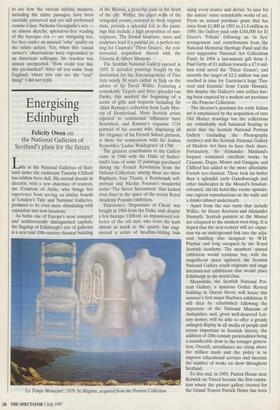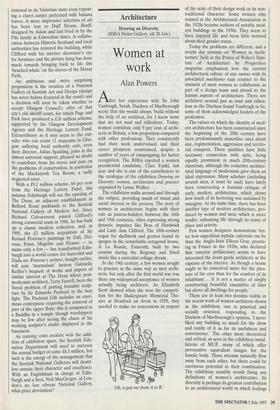Energising Edinburgh
Felicity Owen on the National Galleries of Scotland's plans for the future Life at the National Galleries of Scot- land under the exuberant Timothy Clifford has seldom been dull. His second decade as director, with a new chairman of trustees, the Countess of Airlie, who brings her experience from serving on similar boards at London's Tate and National Galleries, promises to be even more stimulating with expansion into new locations.
As befits one of Europe's most compact and architecturally distinguished capitals, the flagship of Edinburgh's trio of galleries is a neat mid 19th-century classical building at the Mound, a peaceful oasis in the heart of the city. Within, the claret walls of the octagonal rooms, restored to their original state, provide a splendid foil to the paint- ings that include a high proportion of mas- terpieces. The formal furniture, vases and sculpture lend it a palatial air, a perfect set- ting for Canova's 'Three Graces', the con- troversial acquisition shared with the Victoria & Albert Museum.
The Scottish National Gallery opened in 1859. It included paintings bought by the Institution for the Encouragement of Fine Arts nearly 30 years earlier in Italy on the advice of Sir David Wilkie. Featuring a remarkable Tiepolo and three splendid van Dycks, this marked the beginning of a series of gifts and bequests including Sir Allan Ramsay's collection from Lady Mur- ray of Henderland. Many Scottish artists exposed to continental influences have flourished, and Ramsay's exquisite 1754 portrait of his second wife, displaying all the elegance of his French School pictures, is there for comparison with Sir Joshua Reynolds's 'Ladies Waldegrave' of 1780.
The greatest contribution to the Gallery came in 1946 with the Duke of Suther- land's loan of some 25 paintings purchased during the French Revolution from the Orldans Collection; among these are three Raphaels, four Titians, a Rembrandt self- portrait and Nicolas Poussin's wonderful series 'The Seven Sacraments' that looked even finer in the space of the recent Royal Academy Poussin exhibition.
Tintoretto's 'Deposition of Christ' was bought in 1984 from the Duke, and, despite a few hiccups, Clifford, an impassioned col- lector of the old style who loves the hunt almost as much as the quarry, has engi- neered a series of headline-hitting bids `Le Temps Menacane, 1929, by Magritte, acquired from the Penrose Collection using every source and device 'to save for the nation' some remarkable works of art. From an annual purchase grant that has risen from £1,000 in 1903 to £1.8 million in 1989, the Gallery paid only £184,000 for El Greco's Tabula' following an 'in lieu' arrangement and contributions from the National Memorial Heritage Fund and the ever supportive National Art Collections Fund. In 1994 a last-minute gift from J. Paul Getty of £1 million towards a £7.6 mil- lion total saved the 'Three Graces', and recently the target of £2.2 million was just reached in time for Guercino's huge 'Tan- cred and Erminia' from Castle Howard, this despite the Gallery's own coffers hav- ing been emptied by a modern art purchase — the Penrose Collection.
The director's penchant for early Italian art is emphasised by the acquisition of rare Old Master drawings but the collections are remarkably well balanced bearing in mind that the Scottish National Portrait Gallery (including the Photography Archive) and the Scottish National Gallery of Modern Art have to have their share. Fortunately, Sir Alexander Maitland's bequest contained excellent works by Cezanne, Degas, Monet and Gauguin, and Clifford has added to the more affordable French neo-classical. These look far better than a splendid early Gainsborough and other landscapes in the Mound's boudoir- coloured, chi-chi hotel-like rooms upstairs: one expects reproductions on the walls and a drinks cabinet underneath.
Apart from the star turns that include Wilkie, Sir Henry Raeburn and Alexander Nasmyth, Scottish painters at the Mound are relegated to the modern west wing. It is hoped that the next century will see expan- sion via an underground link into the adja- cent building also designed by W.H. Playfair and long occupied by the Royal Scottish Academy. The members' annual exhibition would continue but, with the magnificent space updated, the Scottish National Gallery could originate and stage international exhibitions that would place Edinburgh in the world class.
Meanwhile, the Scottish National Por- trait Gallery, a spacious Gothic Revival building in Queen Street, will house this summer's first major Raeburn exhibition. It will then be refurbished following the departure of the National Museum of Antiquities, and, given well-deserved Lot- tery money, will be able to offer a greatly enlarged display in all media of people and events important in Scottish history, the addition of 20th-century personalities being a considerable draw to the younger genera- tion. Overall, attendances are rising above the million mark and the policy is to improve educational services and increase the number of works on show throughout Scotland.
To this end, in 1993, Paxton House near Berwick on Tweed became the first outsta- tion where the picture gallery created for the Grand Tourist Patrick Home has been restored to its Victorian state even repeat- ing a claret carpet patterned with banana leaves. A more impressive selection of art has been lent to Duff House, Banff, designed by Adam and last lived in by the Fife family in Edwardian times. A collabo- ration between Historic Scotland and local authorities has restored the building, while Clifford with his interior decorator's eye for furniture and the picture hang has done much towards bringing back to life this `beached whale' on the shores of the Moray Firth.
An ambitious and more surprising proposition is the creation of a National Gallery of Scottish Art and Design (design has never before featured in the remit) and a decision will soon be taken whether to accept Glasgow Council's offer of that city's old sheriff court, for which Page and Park have produced a £28 million scheme, supported by the Glasgow Development Agency and the Heritage Lottery Fund. Extraordinary as it may seem to the out- sider who can count 11 museums in Glas- gow suffering local authority cuts, even their director, Julian Spalding, joins in the almost universal support, pleased no doubt to contribute from his stores and pass on the problems of conservation, in particular of the Mackintosh Tea Room, a sadly neglected asset. With a £9.2 million scheme, 68 per cent from the Heritage Lottery Fund, this autumn Edinburgh will see the opening of The Dean, an adjacent establishment in Belford Road parklands to the Scottish National Gallery of Modern Art. Since Richard, Calvocoressi joined Clifford's strong curatorial team in 1986, he has built up a classic modern collection, and, in 1995, the £3 million acquisition of Sir Roland Penrose's paintings by Dali, Del- vaux, Ernst, Magritte and Picasso — to name only a few — has transformed Edin- burgh into a world centre for Surrealist and Dada art. Penrose's archive, bought earlier, will join 'marmalade' heiress Gabrielle Keiller's bequest of works and papers of similar interest at The Dean where post- modernist architect, Terry Farrell, faces the literal problem of putting bnitalist sculp- ture by Sir Eduardo Paolozzi in the best light. The Paolozzi Gift includes an enor- mous centrepiece requiring the removal of part of the upper floor: this is compared to a Buddha in a temple though worshippers may be few after seeing the chaos of his working sculptor's studio displayed in the basement. As running costs escalate with the addi- tion of exhibition space, the Scottish Edu- cation Department will need to increase the annual budget of some £6.5 million, but such is the energy of the management that the Scottish National Galleries will doubt- less sustain their character and excellence. With an Englishman in charge at Edin- burgh and a Scot, Neil MacGregor, at Lon- don's no less vibrant National Gallery, what price devolution?



























































 Previous page
Previous page